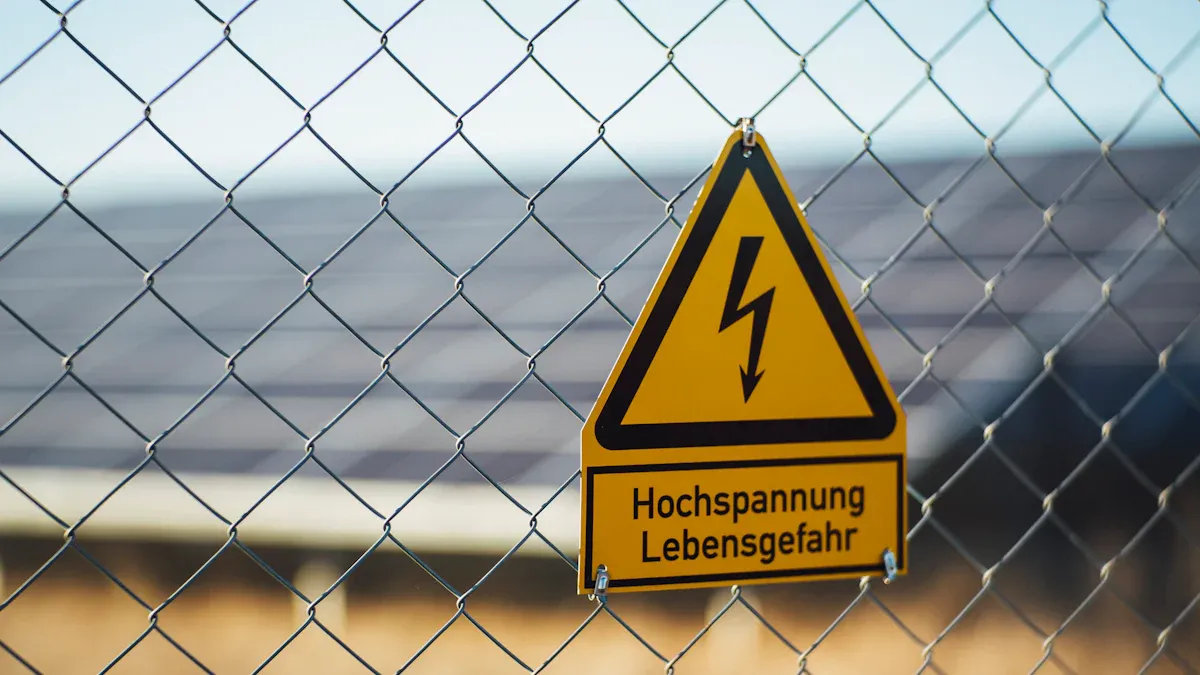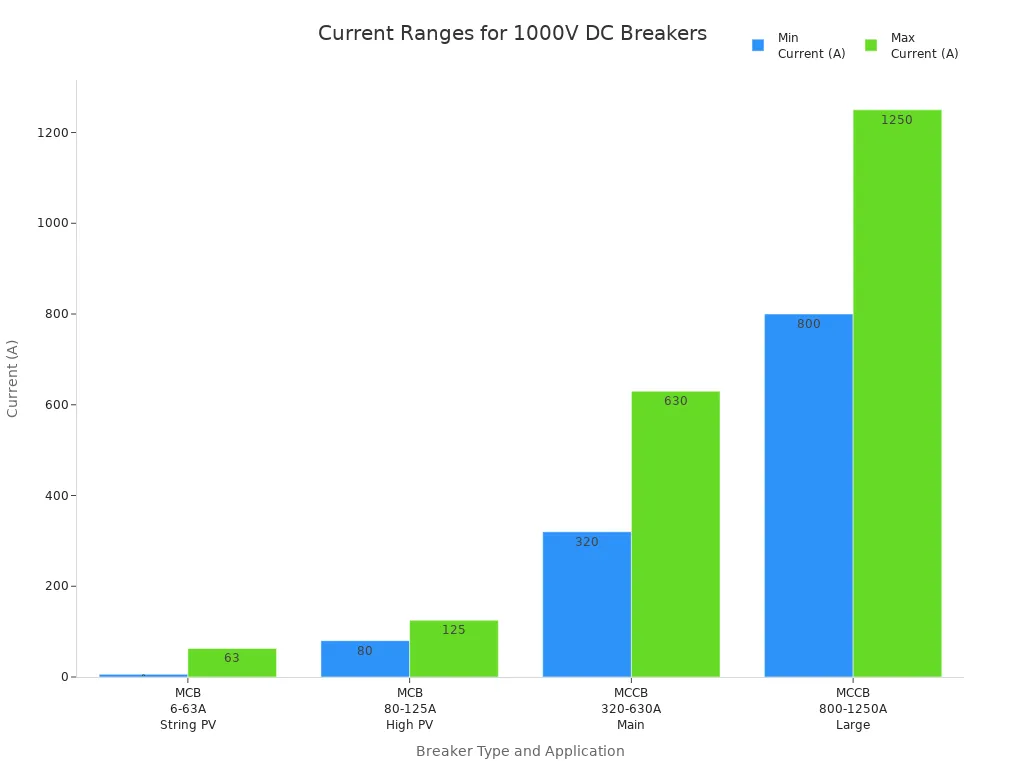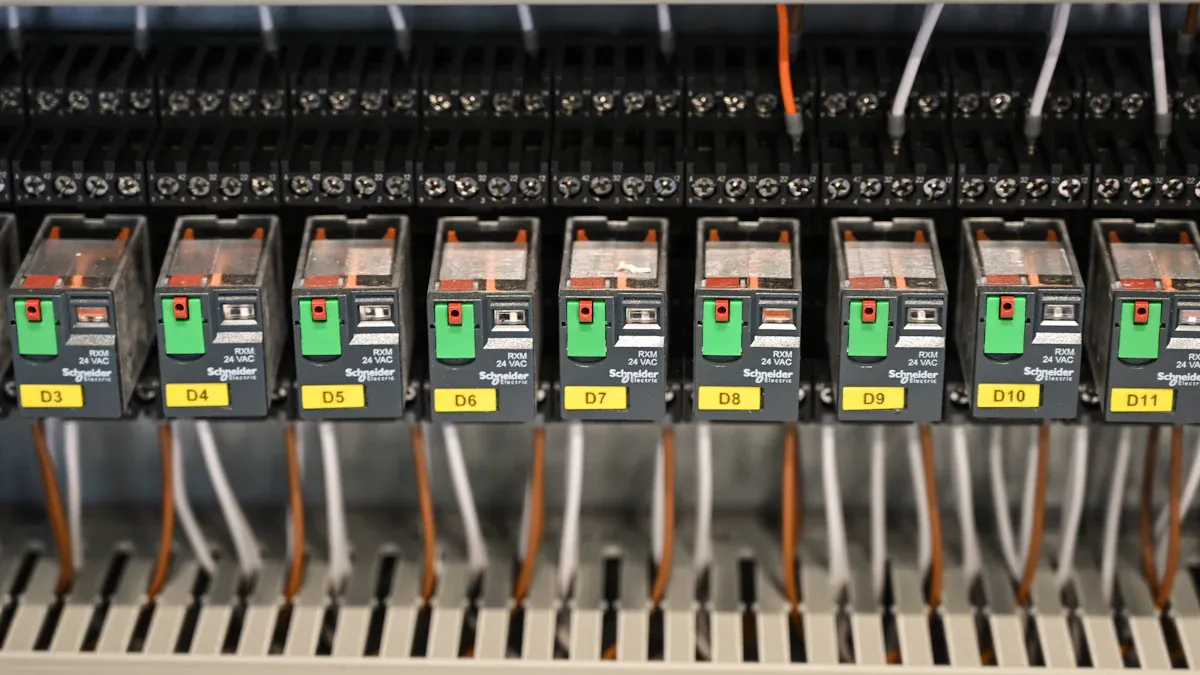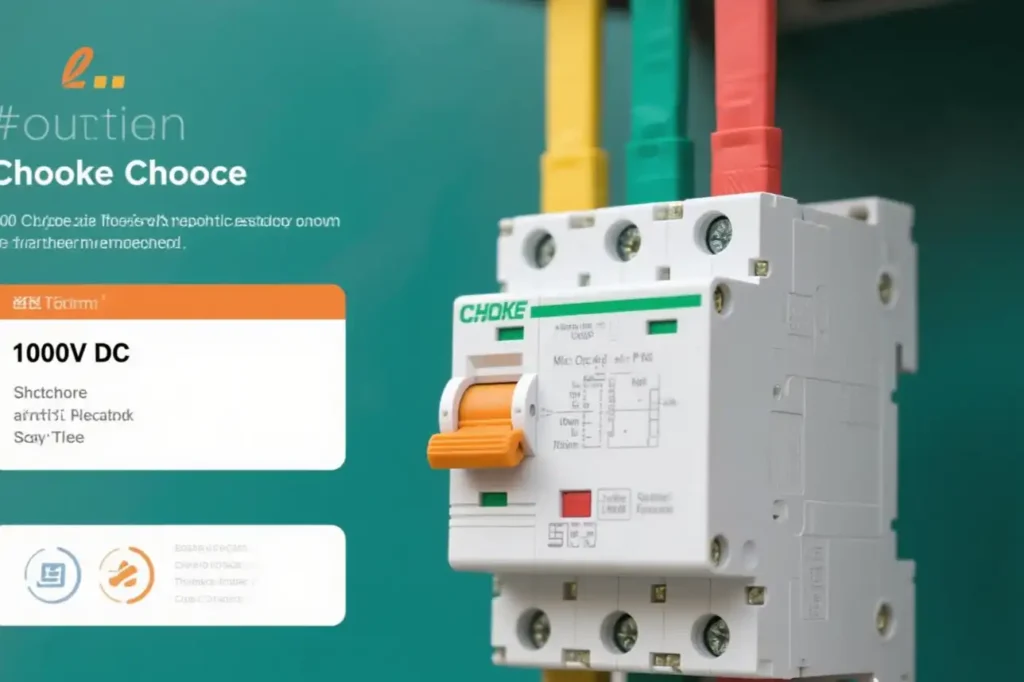You must pick a 1000V DC circuit breaker carefully to keep people and equipment safe. If you choose the wrong breaker or put it in the wrong way, big problems can happen. Some safety issues are breakers not stopping faults, sparks from dust or water, and parts breaking so the breaker does not work. If you keep turning a tripped breaker back on, it can become very unsafe. Always use the maker’s instructions and follow safety rules. Paying close attention to ratings and how you install the breaker helps stop electric shocks, burns, or even blasts in dangerous places.
Key Takeaways
- Always pick a circuit breaker with the right voltage rating. Make sure it matches or is higher than your system’s highest DC voltage. This helps keep things safe and stops electrical problems.
- Figure out your system’s load current carefully. Use the 125% rule to choose a breaker size. This protects your equipment and stops false trips.
- Look at the breaker’s interrupting rating. Make sure it can safely stop the biggest fault current in your system.
- Pick the correct trip curve and breaker type for your load and use. This stops unnecessary trips and gives good protection.
- Think about where you will install the breaker. Choose breakers with the right certifications and enclosure ratings. This makes sure they work well and last a long time.
Voltage Rating

Match System Voltage
You need to make sure your circuit breaker matches your system’s highest DC voltage. If your system uses 1000V DC, pick a breaker rated for at least 1000V DC. This keeps your equipment safe and stops electrical problems. International rules, like IEC/EN 60947-2, tell how DC circuit breakers should work. Companies such as ABB and GEYA make breakers that follow these rules. Their breakers have voltage ratings from 250V up to 1000V DC. These rules help you pick the right breaker for your system. They also make sure the breaker works well in hard conditions.
Tip: Always check the highest voltage your system can reach. Never use a breaker with a lower voltage rating than your system. This can cause dangerous problems.
1000V DC Circuit Breaker Selection
When picking a 1000V DC circuit breaker, you should think about a safety margin. Experts say to choose a breaker rated at or above your system’s voltage. For a 1000V DC system, use a breaker with a 1000V DC rating. This gives you good protection and follows the best advice.
Here is a quick reference table:
| Parameter | Recommended Range | Consideration |
|---|---|---|
| Voltage Rating | 750-1000V DC | Should match or be higher than your system voltage. Pick breakers rated at or above 1000V DC for 1000V systems. |
If you work with solar power, you need to watch the open-circuit voltage (Voc). Voc is the highest voltage your solar panels can make when not connected to anything. Voc stays about the same most of the day, but temperature changes can make it go up or down. Cold weather makes Voc go up. Hot weather makes Voc go down. Designers use the Voc temperature coefficient to plan for these changes, especially in cold places. You should add at least 20% to the highest Voc when picking your breaker. This helps stop overvoltage problems and keeps your system safe.
- Voc goes up in cold weather and down in hot weather.
- Voc changes slowly during the day, mostly because of temperature.
- Wind and weather can change cell temperature and affect Voc.
- Voc is a reference voltage, not the voltage your system uses all the time.
- Always use the Voc temperature coefficient to plan for safe use.
If you follow these steps, you will pick a 1000V DC circuit breaker that fits your system and keeps it safe. You protect your equipment and follow international rules.
Current Rating
Calculate Load Current
You need to know your system’s load current first. Check the highest current your equipment uses when working. Use real operating conditions, not just what the label says. Electrical codes like NFPA 70E and the NEC say this is best. Ohm’s Law helps you find voltage drop and load current. The NEC ampacity tables help you pick wire size and check your math.
Tip: Always keep voltage drop under 2%. This makes your system work well and stay safe.
Here is a table that shows how to figure out load current and wire size for 1000V DC systems:
| Aspect | Description |
|---|---|
| Calculation Method | Use Ohm’s Law: Vdrop = Iload × Rcable. Rcable comes from NEC Chapter 9, Tables 8 and 9. |
| Conductor Resistance Source | NEC Chapter 9, Tables 8 and 9 (stranded conductors, DC or AC 60Hz) |
| Ampacity Reference | NEC Table 310.15(B)(16) for 60°C insulated conductors rated 0-2000V |
| Voltage Drop Recommendation | Try to keep voltage drop as low as you can, less than 2%. |
| Units | American Wire Gauge (AWG) and feet |
| Operating Conditions | Assumes 3 or fewer wires in a raceway, with air at 30°C (86°F) |
You can see common current ranges in solar and battery systems. String and sub-array breakers often handle 6 to 63 amps. Main circuit breakers in big solar or battery systems may need 320 to 1250 amps.
| Breaker Type | Rated Voltage | Typical Current Range (A) | Application Context |
|---|---|---|---|
| LETOP 1000V DC MCB | 1000V DC | 6 – 63 | String and sub-array protection in PV systems |
| LETOP 1000V DC MCB | 1000V DC | 80 – 125 | Higher current MCBs for PV systems |
| LETOP 1000V DC MCCB | 1000V DC | 320 – 630 | Main circuit protection in commercial/utility scale solar and battery storage |
| LETOP 1000V DC MCCB | 1000V DC | 800 – 1250 | Large scale main circuit protection |

Apply 125%-150% Rule
Once you know your load current, use the 125%-150% rule. This rule helps you pick a breaker that works right and keeps your system safe.
- Use the 125% rule for loads that run all the time, like solar inverter outputs. Multiply your highest load current by 1.25 to get the smallest breaker size.
- For diversion control circuits, use the 150% rule. Multiply the highest current by 1.5 for these cases.
- The NEC says DC circuit overcurrent devices must be rated at least 125% of the highest current you figured out. This keeps wires and connections safe.
Note: The 125% rule stops the breaker from tripping too much because of heat. It also protects wires and ends when running all the time.
Here is an easy example:
If your solar inverter puts out 100A all the time:
Minimum breaker size = 100A × 1.25 = 125A
Think about the environment too. High temperatures, bad airflow, and high places can change how the breaker works. If your system runs above 40°C or in tough spots, you need to lower the breaker rating. Most experts say use a factor of 0.8 for pretty high temperatures and 0.7 for very tough conditions.
- Lower by 20% if the air is colder than -40°F or hotter than normal.
- Lower for bad airflow or high places.
- Do not lower too much, or you might need huge wires and lose protection.
Tip: Always look at the maker’s datasheet for lowering rules. This makes sure your breaker works safely where you use it.
By doing these steps, you pick the right current rating for your circuit breaker. You keep your system safe, stop false trips, and follow the rules.
Breaking Capacity

Interrupting Rating
You must check the interrupting rating before you choose a circuit breaker. This rating tells you how much short-circuit current the breaker can safely stop. If you pick a breaker with a low interrupting rating, it may fail during a fault. You want a breaker that matches or exceeds the highest fault current your system can produce.
- The c3controls Series 1110 DC Miniature Circuit Breakers can handle up to 1000V DC.
- These breakers have a short-circuit current interrupting rating of 10kA. This is the highest rating you will find for DC miniature circuit breakers up to 1000V DC.
- You can find these breakers in one to four-pole designs. They cover current ratings from 0.5A to 63A.
- These breakers are UL 489B listed. This means they meet safety standards for photovoltaic renewable energy systems.
Tip: Always check the interrupting rating on the breaker’s label. Make sure it is high enough for your system.
Fault Current Assessment
You need to figure out the maximum fault current in your system. This step helps you pick a breaker that will work safely. The process can be tricky because standards do not give a simple formula for DC systems. You can use UL 508A Supplement SB to find the Short Circuit Current Rating (SCCR) for your panel. This method looks at the fault current at the point where your system connects to the grid. You also need to add any current from loads that can supply fault current.
IEEE Std 551, known as the Violet Book, gives advice for calculating fault current in distribution systems. It does not give a direct formula for 1000V DC systems. The NEC says you must test or use approved methods to find SCCR. UL 508A SB is the main method, but it does not count drives as current-limiting devices. If you have devices behind a rectifier or drive, they are isolated from AC supply fault current. You should consider the drive’s current-limiting ability, but UL 508A does not recognize this yet.
Note: Always use the highest possible fault current when you select your breaker. This keeps your system safe and meets code requirements.
Trip Curve & Breaker Type
Select Trip Curve
You need to pick a trip curve that fits your load. Trip curves show how fast a breaker reacts to too much current. If you pick the wrong one, the breaker may trip too much or not protect well. Motors and transformers use a lot of current when they start. You need a trip curve that lets them start without tripping.
Here is a table to help you compare trip curve types for DC circuit breakers:
| Trip Curve Type | Tripping Current Range | Typical Application | Use in 1000V Solar Systems |
|---|---|---|---|
| A | 2–3 × In | Sensitive electronics | Rarely used in solar systems |
| B | 3–5 × In | Household appliances, lighting | Good for residential solar panels |
| C | 5–10 × In | Lighting circuits, small motors | Best for commercial solar installations |
| D | 10–20 × In | Large motors, transformers | Ideal for industrial solar systems |
| K | 1.2 × In (thermal), 8–14 × In (magnetic) | Motor circuits | Used for motor protection in solar systems |
Think about these things when you pick a trip curve: Motors need slow trip curves for big starting currents. Sensitive electronics need fast trip curves for quick safety. Solar inverters and transformers often work best with C or D curves. Always check what the maker says for your equipment.
Tip: The right trip curve stops false trips and keeps your system safe.
Choose DC Breaker Type
You must pick the right DC circuit breaker for your job. Each type finds and stops faults in a different way.
- Thermal-magnetic breakers use a metal strip for slow overloads and a magnet for fast short circuits. These are good for most solar and battery systems.
- Hydraulic-magnetic breakers use a liquid and magnet to trip at the right time. They do not change much with temperature but are usually for less than 600V DC.
- Solid-state breakers use electronic parts to sense and stop faults fast. These give more control but are mostly for lower voltages.
Molded case circuit breakers (MCCBs) rated up to 1000V DC give strong protection for high-voltage systems. MCCBs can handle big loads, let you change trip settings, and have safety features like current limiting and trip lights. You can use MCCBs in commercial solar, industrial, and battery storage systems. Some MCCBs work with reverse polarity, which gives you more options.
Note: Always pick a breaker type that fits your system’s voltage, current, and safety needs.
Environment & Quality
Installation Conditions
Think about where you will put your circuit breaker. The place can change how well it works and how long it lasts. If you use your breaker outside, near water, or around chemicals, pick a box with a strong rating. NEMA and IP ratings show how much the box protects against water, dust, and rust.
Here is a table to help you compare enclosure ratings for tough places:
| NEMA Rating | Equivalent IP Rating | Protection Details |
|---|---|---|
| NEMA 4 | IP66 | Keeps out water and dust. You can wash it down. Good for inside or outside. |
| NEMA 4X | IP66 | Like NEMA 4, but also stops rust. Works in chemical plants. |
| NEMA 6 | IP67 | Handles water from hoses, ice, and short dips. Good for hard outdoor spots. |
| NEMA 6P | IP68 | Protects from long dips in water. Best for boats or places that flood. |
Tip: Pick NEMA 4X or NEMA 6P if you need strong protection from water and rust. These ratings help your breaker last longer in tough places.
Check that your breaker has good electrical connections. Look for strong terminal blocks. Make sure you can turn off the breaker by hand. These things help keep your system safe and easy to fix.
Certifications & Reliability
You want a circuit breaker that meets safety rules. Certifications like UL, IEC, and CE mean the breaker passed hard tests for safety and reliability. Here are the most important certifications:
- UL 1066 and UL 489: These rules cover circuit breakers up to 1500V DC. They make sure your breaker is safe and works well.
- IEC 60947: This rule checks safety and how well DC breakers work.
- CE Marking: Needed for selling in Europe. It shows the breaker follows EU rules.
| Certification | Market | Standard | Why It Matters |
|---|---|---|---|
| UL | North America | UL 1066, UL 489 | Makes sure the breaker is safe and does not catch fire |
| IEC | Global | IEC 60947 | Checks safety and how well it works everywhere |
| CE | Europe | CE Marking | Needed for legal sales and following the rules |
Pick breakers from trusted brands. BENY, ChinaminYang, Geya, and Yroenergy all have good records for quality and reliability. These companies use strict checks and offer products with many certifications. BENY gives a five-year warranty and help any time. ChinaminYang uses strong materials and skilled workers. Geya tests every breaker to make sure it works well. Yroenergy makes breakers for solar systems and uses materials that do not burn easily.
Note: Always check for certifications and pick a breaker from a trusted company. This helps you avoid trouble and keeps your system safe.
Before you get a 1000V DC circuit breaker, use this checklist. It helps you pick one that is safe and works well:
| Checklist Item | What to Check |
|---|---|
| Voltage Rating | Make sure it matches your system voltage (like 1000V) |
| Current Rating | Should be 25% higher than your total load |
| Interrupting Capacity | Can stop the biggest fault current your system might have |
| Breaker Quality | Buy from a trusted brand with the right certifications |
| Sizing & Derating | Make sure it fits your wire size and where you use it |
| Breaker Type | Pick the type that works for your job (thermal-magnetic, hydraulic, etc.) |
If you pick the wrong breaker or forget to lower the rating, it can be dangerous. Your equipment could get damaged. For tricky systems, ask an expert or the maker for help. Always check your system details before you buy.
FAQ
What happens if you use a circuit breaker with a lower voltage rating?
If you use a breaker with a lower voltage rating, it may not stop faults. This can cause fires or damage your equipment. Always match or exceed your system’s voltage.
Can you use an AC circuit breaker for a 1000V DC system?
No, you should not use an AC breaker for DC systems. DC arcs are harder to stop. Use a breaker made for DC to keep your system safe.
How do you know if your breaker is certified?
Check the breaker’s label or datasheet. Look for marks like UL, IEC, or CE. These show the breaker passed safety tests.
Do you need to replace a breaker after it trips?
You do not always need to replace it. If the breaker trips often, check for problems in your system. Replace the breaker if it feels hot, looks burned, or will not reset.
What is the best way to size a breaker for solar panels?
First, find your highest load current. Multiply by 1.25 for continuous loads. Pick a breaker with a matching voltage and enough interrupting capacity. Always check the maker’s guide for your system.
See also
Why every solar setup needs a 1000V surge protection device
DC 1000V 4 in 2 out solar combiner box
DC 1000V three in one out solar series connection box
DC 1000V 6 in 2 Out PV Combiner Box
Explaining the Tripping Curves of Type A, B, C, and D MCB



